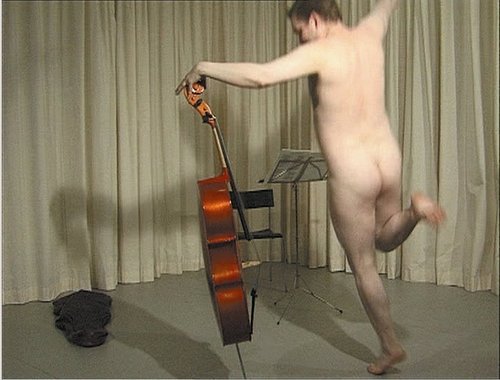Sound of Art. Music and Visual Arts
dal 18/7/2008 al 11/10/2008
Segnalato da
Filippo Tommaso Marinetti
Luigi Russolo
Gunther Uecker
Harry Partch
Conlon Nancarrow
Rodney Graham
Christian Marclay
Cory Arcangel
Manfred Leve
Peter Moore
John Cage
Mauricio Kagel
Peter Land
Arman
Wolf Vostell
Nam June Paik
Peter Sandbichler
Brigitte Felderer
Eleonora Louis
18/7/2008
Sound of Art. Music and Visual Arts
Museum der Moderne, Salzburg
Les Grands Spectacles III. The exhibition features the voice of Filippo Tommaso Marinetti, the noise-making instruments built by Luigi Russolo, examples of Gunther Uecker's terror orchestra, as well as instruments built by Harry Partch and perforated paper music rolls for Conlon Nancarrow's player piano. By blending sound, video, film and photography, artists such as Rodney Graham, Christian Marclay or Cory Arcangel have been exploring the conventions of hearing and seeing in their works during the past decades, and have thus given a new topicality to this theme today.

Curators Brigitte Felderer, Eleonora Louis
At the beginning of the 20th century Futurists and Dadaists introduce sound as a
medium of visual arts; both spoken words and instrumental sounds are newly reinterpreted.
Old systems are destroyed in actions of demolition and self-destruction to create new
sound and perception events. Modern life and sounds of the street (cars, airplanes,
machines) now produce the sounds which are defined as music. Luigi Russolo invents
noise-making instruments, the so-called Intonarumori, with the aim to articulate the
“musical poetry of technology”. Three of these strange sounding bodies are on display
in the exhibition. Not only are traditional instruments modified or new instruments
invented, they also no longer produce the familiar harmonious tones, but noises quite
contrary to the accustomed melodious sounds.
The exhibition features the voice of Filippo Tommaso Marinetti, the noise-making
instruments built by Luigi Russolo, examples of Günther Uecker’s terror orchestra, as
well as instruments built by Harry Partch, which are rarely shown in Europe, and
perforated paper music rolls for Conlon Nancarrow’s player piano.
Destroying well-known traditions also means finding new musical qualities. John Cage
is one of the protagonists of this movement, introducing – in theory and practice – a
new fusion of art genres with regard to sound organisation and listeners’ perception
into the world of music and arts. Cage has exerted a significant influence on the
oeuvre of numerous artists and musicians, ranging from Fluxus artists to
contemporary artists such as Manon de Boer. Fluxus has influenced post-war modern
art like no other art movement. In the 1960s it led to the development of an art
movement characterized by an intensive cooperation between visual artists and
musicians.
Officially founded in 1962 by George Maciunas in New York, the first event was held
as early as 1957. Participators in this event also included John Cage. It goes without
saying that the live character of performances or actions cannot be repeated
authentically within the framework of an exhibition. Nevertheless, photographs by
Manfred Leve or Peter Moore, for example, which document countless artist
performances from 1950 until today, give viewers an immediate impression of
events and also have their own aesthetic character.
Not only instruments, but also scores and sound storage media such as records,
audiotapes etc. are modified and transformed from a carrier of music into an art
object. In the 1960s and 1970s a young generation of German and Berlin-based
Austrian artists promote the integration of music into visual arts as an artistic
attitude. Small groups of artists perform as music/ performance groups, mainly in
Berlin, Dusseldorf and Cologne.
Mauricio Kagel is also represented in the exhibition as a mediator between music and
film. In his works, scores are replaced by theatrical instructions to the musicians, and
his “music films” have a surreal quality. The children’s instruments developed by
Kagel and the artists who participated in his film Ludwig van, including Joseph Beuys,
Dieter Roth and Stefan Wewerka, testify to an audiovisual phantasy that cannot deny
Kagel’s personal acquaintance with the art scene of the 1970s, especially in the
Rhineland.
By blending sound, video, film and photography, artists such as Rodney Graham,
Christian Marclay or Cory Arcangel have been exploring the conventions of hearing
and seeing in their works during the past decades, and have thus given a new
topicality to this theme that today also includes footage found on the world wide web.
A richly illustrated catalogue will be published in conjunction with the exhibition by
Bibliothek der Provinz. Price: €33
Press contact
Christine Forstner T +43.662 84 22 20-601 F +43.662 84 22 20-701 christine.forstner@mdmsalzburg.at
Presse Freitag 18.7.08, 11.00 Uhr
Image: Peter Land, The Cellist, 1998 Filmstill der DVD-Videoinstallation © Peter Land; Courtesy Galleri Nicolai Wallner, Copenhagen
MdM Mönchsberg
Monchsberg 32 5020 Salzburg Austria



